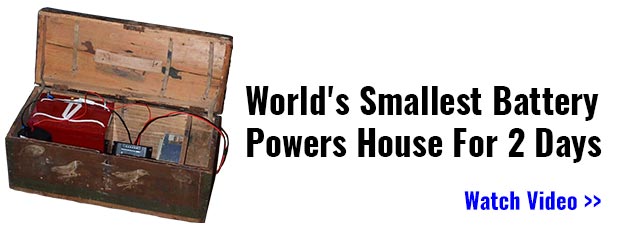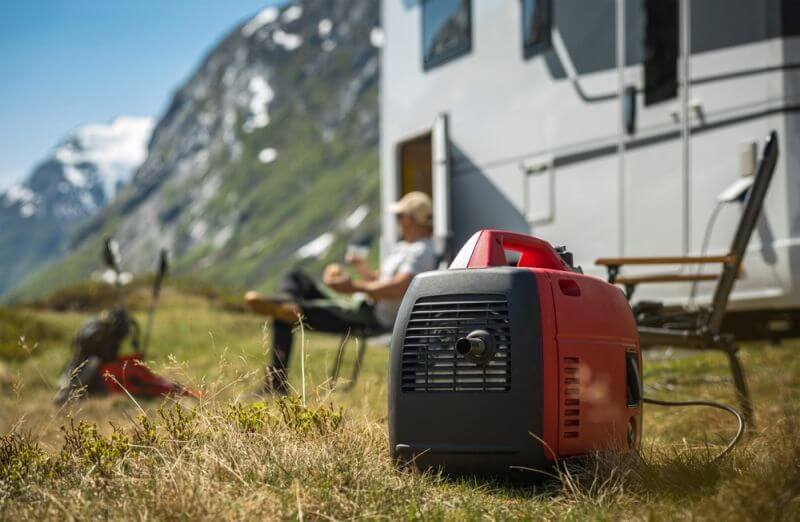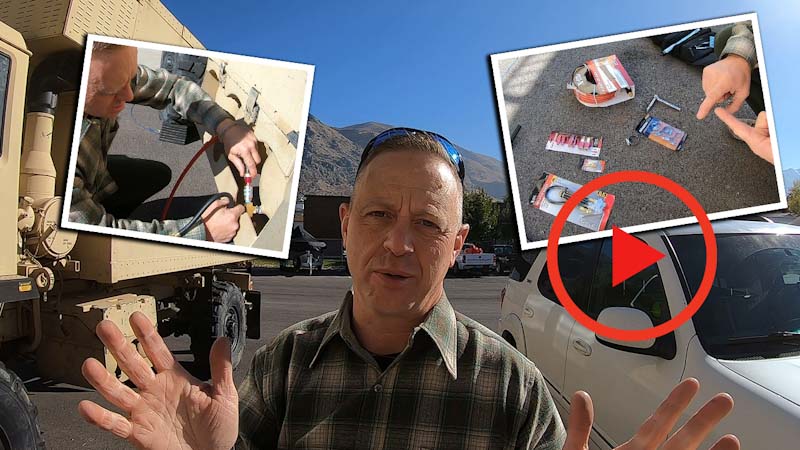Regardless of the device you are talking about, there are always going to be weak points that will lead to the device being discarded.
When it comes to power generators, the part that actually produces the electricity may still work, even though the entire unit has been discarded.
If you can’t afford a brand new generator, or are concerned about the cost of fuel, finding a scrapped out generator might be a good start. Depending on the reason for it being discarded, you could modify it to turn solar or wind power into electricity.
From taking steps to get off the grid, to preparing for a major emergency such as we’re seeing in Puerto Rico and California, knowing how to convert a scrapped out generator is a skill that would provide you and your family a warm shelter.
Once you are successful in converting your own generator to harness solar and wind energy sources, there is every chance that you can turn this into a saleable trade and time of need.
Get a Shop or Repair Manual
Before you start taking any generator apart, you should have a shop manual or a repair guide available, as it will provide information on how to test out key parts of the generator, as well as the names of all the parts within the unit.
While you may not necessarily be concerned about getting the engine started, you may still need to make repairs on the portion that generates electricity. The manual should also give you accurate information on how to separate these units so that the electric generating portion will not be ruined in the process.
Whether you need to replace fuses, wires, or other parts of this unit, having the part numbers in hand will make it easier to find them through various resources. This includes looking for compatible parts from other scrapped out units, or even locating materials that you can use to fabricate your own.
This smart device will help you slash an excess of 70% off your power bill overnight…
In some ways, taking apart a generator isn’t so different from working with an automobile engine or even a lawn mower engine. If your intent is to take the device apart from the top down for the purposes of cleaning, refurbishing, or repair, the blow up diagrams in repair or shop manuals will always be of value.
From a purely practical standpoint, even if you’re careful when laying out the internal parts of a complex device, you might set them in the wrong place, or forget how to put them back where they belong. This is when the shop manual for repair guide becomes useful, as it offers you a map and help you make significant changes in order to harness solar and wind power.
At that point, you should already be well on the way to creating suitable notes so that you will never have problems during the repair, cleaning, or refurbishing processes.
Be Ready to Take Notes
Since a wind turbine spins, you may think that it is much easier to convert a generator to run on this source. This is true to some extent, but you should also take notes on the exact parts used to connect the generator part to the driving section of the wind turbine.
Also converting heat or light from solar power sources into a means of driving a generator will also require separate modules composed of several parts. If you don’t take notes on how these parts fit together, what they are, and how to take care of them, you may wind up having many problems later on.
Whether you need to oil a shaft that has close tolerances, or another part that may wear faster than expected, these notes will help you make repairs faster and also ensure that maintenance protocols are effective. This includes giving you a chance to choose different materials from ones that may have failed in your first efforts.
The Basic Parts of a Generator and How to Adapt Them
Before you begin taking the generator apart, think about the following modules, and how they will either work or not work with the new power source you are considering adapting the generator to work with.
Video first seen on Brags & Hayes, Inc.
The engine and fuel system
Since most generators available for consumers use internal combustion engines, it is very likely you will be removing this part of the generator and replace it with something else.
A great deal will depend on what renewable source of power you decide to use. For example, if you decide to work with biofuels or natural gas, it may still be possible to use the internal combustion engine with some modifications to the fuel input systems.
On the other hand, if you are going to work with solar or similar forms of power, an internal combustion engine will be of no use. In fact, you may actually wind up building a steam engine if the main power you are able to capture is heat.
Lubrication, cooling, and exhaust systems
For the most part, you will find that the exhaust system will apply mainly to the internal combustion engine. Therefore, if you are discarding the internal combustion engine, you will not need to worry about the existing exhaust system. Depending on the generator model, there may or may not be additional lubrication required for the alternator.
Since the alternator itself is optimized to work with a specific engine, you may want to make a more careful study of all moving parts inside the alternator. A non-optimized driving source can increase wear on the internal parts of the alternator and cause them to break down faster.
Lubricating these areas may or may not be of help. If lubrication reduces wear, however, it can mean the difference between a generator that lasts only a matter of days or weeks, and one that will serve you well for several years.
Insofar as the cooling system, it is very likely that the alternator will need a separate cooling system if it doesn’t already have one, or if the cooling system is heavily tied to the engine.
The alternator
At its simplest definition, the alternator is little more than a tightly wound coil of conductive wire (usually copper) surrounding a magnetic core. As the magnetic core spins, an electrical current is induced in the coil.
From there, leads extending from the coil deliver electricity to other locations. No matter what causes the magnetic core of the alternator to spin, the electrical current will still be generated. This in turn, means that the alternator is the most important part of the generator for your purposes.
Since coils can be very difficult to wrap in large volumes, it may not be possible to repair an excessively worn alternator core. Therefore, when you are evaluating a scrapped out generator, start by testing out the alternator part before it looking at other sections of it. If the alternator is burned out or it does not function properly, you’ll have to build your own coils and magnet system.
Do not forget that there can be a loss of efficiency in less compact designs, however it is more likely you can wrap less compact coils without using complex machinery and get some current from them.
The voltage regulator
This part of the generator takes output from the alternator and modifies it so that the voltage, or force of the current, remains stable over time. Depending on the generator, you may have outputs from the voltage regulator that provide DC at varying voltages, and outputs that provide AC.
As with the alternator, the voltage regulator should be one of the first things that you test out to see if it still works. If it doesn’t work, you may still be able to refurbish or repair it. A great deal depends on how much of the regulator relies on solid state chips, and if they can be replaced with older style electronic parts.
Later on, you may want to integrate a joule thief somewhere in the system, or some other device that will increase the output of the generator without compromising voltage stability.
The control panel
If you are looking at a relatively new generator, or one that has been built in the last few years, then the entire generator system is operated by a series of computers. This will also include computers used to run the engine and control his performance, as well as independent systems that govern the alternator and voltage regulator.
It may not be all that easy to bypass one computer module and simply go on using the others. A great deal will depend on the specific model you are working with, and what you find in the repair manual.
Aside from modifying the purely mechanical parts of the generator, you may also need to interface with the control panel, using Arduino or some other programmable chip system.
Alternative Fuel Options
If all parts of the generator are still working (as in may just need some cleaning or refurbishing), and you want to try the most simple modifications, your best option will be to look for alternative fuels for the engine.
Natural gas, biofuels, or anything else that can be burned in an internal combustion engine May suit your needs. Unfortunately, if you have a newer generator, you may need to make substantial changes to the air-fuel mixture system and anything that governs it.
For example, if the engine has fuel injectors, you will probably need to replace them with a carburetor. As with a conventional automobile, you may need to do extensive work to modify or remove all the parts downstream that are controlled by computer-driven module.
When it comes to fuel options, do not forget about manifold modifiers that use electrolysis to produce hydrogen. You may also want to look into adapters that will allow you to replace some of the fuel with water.
Historically speaking, these devices are very controversial, and many people claim they don’t work. That being said, if you are interested in experimenting with these devices, a scrapped out generator engine may be an ideal device to work with.
If you can improve fuel efficiency on your generator, you may have a better chance of producing the same results with your vehicle.
How to Use the Generator With Driving Power Forms
As noted earlier, the alternator portion of the generator produces electricity when a central shaft spins. This shaft can be driven by the rotation from wind turbine blades just as easily as it can be driven by a gasoline engine, a water wheel or just about anything else that produces a spinning motion.
When you take the generator apart, you’ll find that the central shaft is attached to the engine using a bolt or some other assembly.
You should still be able to modify it to accept a pulley, or some other adapter that will make it easier to spin the alternator shaft with some other source of power.
Even though they are very much in their infancy, using magnets to produce spin engines is something well worth considering. Did you know that you can take something as simple as two fidget spinners with magnets mounted on them and get them to spin for hour on end without any other power input?
From that perspective, if you can get large enough ball bearings a suitable frame and magnets, you may be able to get enough torque from this kind of system to spend the alternator.
As an even further advancement into experimental options, consider using sound and other vibrations to generate a spinning motion. Liquid mercury and other forms of gyroscopes may also offer some areas of investigation; provided you can get sufficient torque from them.
How to Use the Generator with Heat and Steam Engines
Unlike using solar panels to harness the power of the sun, you will find that driving a generator is a very different process. Typically, the easiest way to do this is to use heat captured from the sun to convert water into steam; and then used pressure from the steam to spin a turbine.
You can study designs for both ancient and modern steam engines to see which one is most feasible for you to build.
There are also several other kinds of heat engines that you can use to spin the alternator. Bear in mind, however, many of these systems are not mechanically strong.
For example, a rubber band heat engine may fall apart if it must apply anything more than a minimal amount of torque to spin a central shaft. As such, if you want to take advantage of these kinds of heat engines, it is very important to consider your materials carefully.
What About Multiple Input Options?
As you consider different systems for generating power, you’re going to find that there is no such thing as one system that will generate all the power that you need. You’re also likely to find that it takes a considerable amount of money and effort to build one system that is large enough to power an entire household.
On the other side of the equation, there are many smaller systems that can generate 12 volts of electricity or small enough amounts of torque to achieve this goal. If you are determined to use a scrapped out generator to produce larger amounts of voltage, it may make some sense to see if you can combine the smaller systems to drive the larger one.
Simple machines such as pulley and belt systems and other machines built on the fundamentals of physics may be of some help to you. Just remember that each time you add a new system, you will also lose some of the energy or torque in the process.
When it comes to using scavenged materials to produce electricity, scrapped out generators are probably some of the most fascinating because they were already successfully used for generating electricity.
As long as you can differentiate between all of the modules that make up a generator, and make repairs to the alternator and voltage regulator, tyou could use those parts in conjunction with solar, wind, water, or even magnetic engines. If you have a good handle on biofuels, then you may also want to see what you can do with the engine itself.
Aside from producing something workable, you will also be acquiring valuable skills and experiences that can be of use in forming a new career now, or as part of a marketable trade in time of need.
This article has been written by Carmela Tyrell for Survivopedia.









Evan | October 29, 2017
|
Look for old wrecked or discarded motorhomes. Many still have their gensets still in them. most were built by Onan and parts are easy to get. I have found generators bought when ice storm hits never used and left in a garage for several years then sold for 1/4 the cost in a yard sale.. Can sometimes get them at the dump with the lawn mowers and small engine power equipment stuff.
John Albertson | October 29, 2017
|
I read the article about converting a gas generator to a wind power and there was no mention of controlling the speed from wind to to the rpm’s of the generator. If there is 30 mile winds then it your generator will spin at higher rpm’s than it would at wind speeds at 15 mph. What would you use as a governor to regulate the generator speed so it will not spin to fast or to slow and not burn out
old bull | October 30, 2017
|
John,
in the 1950s i went with my dad to visit his friend. They both worked at the Lockheed skunk works. He was living off the grid. he has a dozen or so of auto alternators being driven by wind power.
he has designed a thin fiberglass blade that would self-feather itself the faster it rotated. Also it had lift so it push back against the wind. He could build a tower very light weight and low cost.
each alternator was on the top of the tower. it had a “rudder” to turn it to face the wind. there were five curved thin fiberglass blades with about an eight foot diameter. As it rotated it pushed back against the wind to keep the tower from blowing over. the curve in the blade would flatten out as it speed up. So the system was self regulating.
also if the controller increases the load on the alternator the alternator will try to brake itself.
Good Luck
Tim WoodArt | November 14, 2017
|
This system will not govern a wind generator to exactly 60 cycles per second as most powered equipment requires these days. The only reliable system would be to generate direct current and use a battery pack and an inverter to power computer-controlled devices, such as just about every appliance in your house. The only reason to govern the speed pf a wind generator is to prevent it over-speeding and blowing itself up. The alternators from automobiles already have a system of diodes to send direct current out to charge the battery. If you check, you will find that auto alternators require quite high speeds to produce useable current.
Bill in Idaho | October 29, 2017
|
HELLO, Carmela T. You Always do Good Work. Thank You. Some brief Notes of Value. Lets be Very Careful in the use of the terms – Generator vs. Alternator. These are substantially different. An ALTERNATOR produces Alternating Current – 60 CPS (Cycles per Second) at the design RPM for the
115 – 240 Volts AC variety – and 12 Volts DC for the Automotive Variety (Rectified to DC from AC via. a diode bridge rectifier.) An Alternator produces a much flatter power curve (and hence more useful) than does a GENERATOR. You can Easily spot a Generator with its Large Commutator and associated 2 or 4 carbon brushes at one end. Generators produce Power Only within a Narrow RPM range and minimal power outside of that range. In either case, Input power will need to be 5 HP and up for Each. Piston steam engine power can be produced with a Lot of Work to Build it. Don’t even try a Steam Turbine for power – expensive, Very challenging, and dangerous. Bill
Allen | October 29, 2017
|
I think the article was referring to generator as the complete package, as to generate electricity. the automotive style generator went out of style in 1962. they are still in use but not very common.